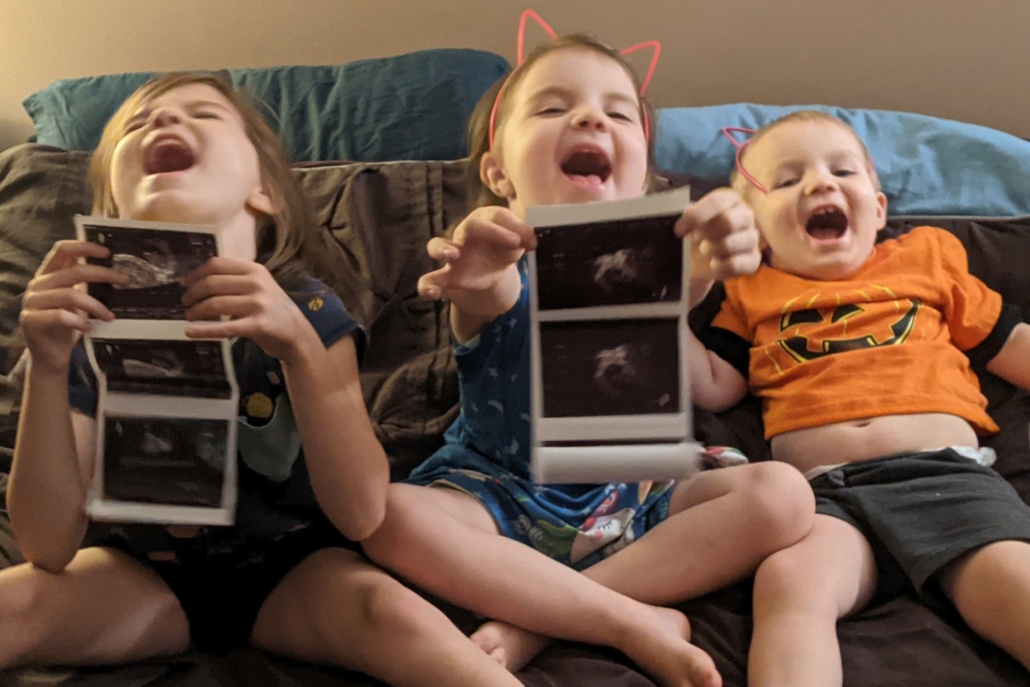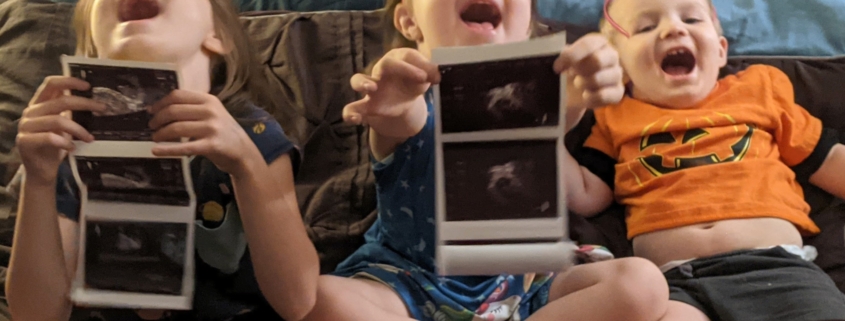Getting an ultrasound the morning the Texas Heartbeat Law went into effect
I’ve long wanted four children. I have a 6-year-old daughter, a 4-year-old daughter, and a 2-year-old son. My son was originally a twin, but we lost his sibling in the first trimester. I grieved (and still grieve), but I also knew that pregnancies with multiples often have problems, and I was not afraid to try again.
[Read more about that experience – Our cultural gaslighting of women who miscarry before 20 weeks]
In April of this year I had a positive pregnancy test. My husband and I were happy and excited, but my feelings were slightly muted as I noticed I didn’t have nearly the symptoms, especially fatigue, I had with my previous pregnancies. We went to the first prenatal appointment looking forward to a doctor reassuring us everything was going well. Instead she told us there was no heartbeat. We cried together in the exam room.
Worse, it was a missed miscarriage, meaning my body did not on its own pass the child’s remains, and I needed to choose between a mifepristone/misoprostol cocktail or a D&C. Either method, in this case, is considered a form of miscarriage management rather than an abortion. Still both methods are commonly used for first trimester abortion, and I couldn’t stand the thought that–instead of going home to post my pregnancy announcement–I was going home to decide how to force my child out of me. I know the mifepristone/misoprostol route takes longer, can involve a lot of pain, requires a follow up appointment to make sure it worked, and, if it didn’t work, requires surgical follow up anyway. So I opted for the D&C. The week leading up to it was filled with anxiety and heartbreak, and both my husband and I were traumatized by it.
We did receive two small comforts: (1) the hospital worked with us to release the remains to a local funeral home, which cremated and released them to us, and (2) the hospital performed genetic testing on the remains and learned our child was a boy, and our son had a fatal trisomy. A trisomy is typically a spontaneous genetic event, and not a sign of any ongoing problems that may affect future pregnancies. The knowledge didn’t give us our son back, but it gave us important information as we considered whether we still want to try for a fourth baby.
After much discussion and some time to think and process, we did decide to try again. I got pregnant in July. This time was very different emotionally. Though I wanted to have a fourth baby, I felt resistant and anxious about taking the pregnancy test. I waited days longer than I needed to, and when I saw it was positive, I was happy but mostly scared. I asked my husband not to tell anyone for now. This time fatigue hit me hard, and I was exhausted every day, but the exhaustion comforted me–my body was clearly doing something. I felt pregnant. Rationally I knew there was no reason to believe anything was wrong, yet still I couldn’t feel much joy. I tried to put catastrophic thoughts out of my mind and just wait for the first prenatal appointment. I try not to expend a lot of emotional energy without more actionable information. It’s hard to do. The weeks dragged on as I waited and waited to get that first ultrasound.
My appointment was set for September 1. That morning, I woke up to find my social media platforms blowing up. Texas had passed a Heartbeat Bill, and instead of getting tripped up in court, it actually went into effect. Abortion activists erupted across Twitter, Reddit, Facebook, etc., and in their rage they argued not only that fetuses aren’t people or that bodily rights trump the right to life, but also that embryos don’t have hearts, and that the familiar rhythmic beat countless parents the world over have heard during our first prenatal appointments isn’t a heartbeat, but merely “electrical activity” that doesn’t have any particular meaning.
[Read more – NPR interviews abortion rights activists to determine if embryos have hearts]
As they vomited these lies all over the internet, my husband and I held hands in the medical center waiting room, trying not to worry. An ultrasound technician called my name, and we went into an exam room with the familiar equipment. The tech talked to me about my history, and I told her that we just had a miscarriage a few months ago and we’re anxious. She was very kind. She said “Well let’s look right now” and had me lay back. My husband tightly held my hand as the tech put the wand on my abdomen. Almost immediately she said “I see the heartbeat” and showed us the machine recording a heart rate in the right range. “Everything looks good.” The relief was so intense I started crying again. My baby is okay. Her heart looks good. It’s going to be okay.

I’ve been involved in pro-life activism for most of my adulthood, but never before had the political noise clashed with the medical reality on such a visceral level. I get used to the same old absurd talking points, but on the morning of September 1, part of me stopped and marveled at how desperate and deep the pro-choice nonsense goes. The loudest cultural voices can howl “there is no heart!” But they can’t stop countless parents from experiences just like mine–the fear in waiting, heartbreak in missing, or joy in hearing our beloved children’s precious heartbeats.
I’m writing this post on November 30. I’m 21 weeks pregnant, and everything is still going well. We’ve since learned our baby is a girl, and I can feel her kick and tumble as I type this. I expect I will feel her sweet, reassuring movements as I stand on a stage in front of the Supreme Court tomorrow to proclaim (loudly) that my daughter’s life is valuable. Your children’s lives are valuable too. I don’t care how forcefully the other side pushes their lies. Our children deserve a lot more than dismemberment on demand and without apology. And I am never, ever going to let this go.
[Read testimonials from people who became pro-life in part because of seeing and hearing their prenatal children’s heartbeats.]




Leave a Reply
Want to join the discussion?Feel free to contribute!